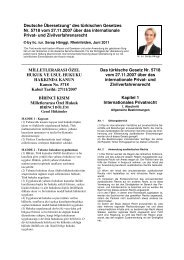WASTEWATER
World%20Water%20Development%20Report%202017
World%20Water%20Development%20Report%202017
Create successful ePaper yourself
Turn your PDF publications into a flip-book with our unique Google optimized e-Paper software.
16.1.3 Industrial water reuse<br />
Industrial water reuse (see Chapter 6) involves<br />
recycling industrial wastewater for industrial uses<br />
(process water) and non-industrial uses (irrigation,<br />
landscape irrigation, non-potable urban uses,<br />
etc.). Industries can also use treated municipal<br />
wastewater. Recycled industrial water has been<br />
used as process water in power stations, textile<br />
manufacturing, paper industry, oil refineries,<br />
heating and cooling, and steelworks for a long<br />
time. New applications of industrial water reuse<br />
are also emerging, such as the use of treated<br />
wastewater as cooling water in big data centres<br />
(for example, the Google data centres in Belgium<br />
and Georgia, USA). More efficient water recycling<br />
and process technologies can ultimately lead to<br />
the closing of the water loop in industries (see Box<br />
14.2), while reducing water use by more than 90%<br />
(Rosenwinkel et al., 2013).<br />
16.1.4 The ‘fit-for-purpose’ concept<br />
‘Fit-for-purpose’ water reuse means that the<br />
required treatment level is defined by water quality<br />
requirements of the intended use. Most nonpotable<br />
reuse options require a quality lower than<br />
that of drinking water, so that secondary treatment<br />
is often adequate (see Section 5.5). However,<br />
barriers to wider applications of this approach<br />
remain, including the lack of appropriate and<br />
flexible regulatory and institutional frameworks.<br />
Potential health and environmental risks can also<br />
be reduced through appropriate safety control<br />
measures, such as the multiple-barrier approach<br />
(WHO, 2006a) (see Section 16.4).<br />
The ‘fit-for-purpose’ water reuse concept has been<br />
successfully applied in the West Basin Municipal<br />
Water District in El Segundo, California, USA (see<br />
Box 12.2), which treats water to five distinct levels<br />
of quality suited for different specific uses (Walters<br />
et al., 2013).<br />
16.1.5 Wastewater use for<br />
environmental benefits – Replenishing<br />
water resources<br />
Common uses of wastewater for environmental<br />
benefits include the replenishment of water<br />
resources through groundwater recharge, river<br />
flow restoration, water augmentation in lakes and<br />
ponds, and restoration of wetlands and biodiversity<br />
(see Chapter 8).<br />
Aquifer recharge. Artificial aquifer recharge<br />
through the intentional injection of treated<br />
wastewater for subsequent recovery or to<br />
enhance ecosystems is a common practice.<br />
The main limitations are related to the aquifers’<br />
BOX 16.4 PHOSPHORUS (P) RECOVERY<br />
GAINING MOMENTUM<br />
The most common form of phosphorus recovery<br />
from wastewater takes place as struvite<br />
precipitation. The most attractive financial options<br />
are those where the recovery takes place early and<br />
allows the operator to save on the costly removal<br />
of unwanted struvite within the treatment system.<br />
However, in view of the sale of the recovered P,<br />
there are no financially attractive options yet that<br />
can compete directly with phosphate-ore-based<br />
fertilizers in the market (Schoumans et al., 2015).<br />
Short-term price volatility, long-term price hikes, and<br />
increasing concern for P insecurity on the political<br />
agenda (relating to concerns of food insecurity and<br />
environmental degradation) may provide additional<br />
incentives for recycled P over unsustainable mining.<br />
Marketing strategies for recovered phosphorus<br />
The Ostara Company in Canada, specialized in<br />
private–public partnerships with wastewater<br />
treatment plants, has successfully applied P-recovery<br />
as crystalline struvite pellets branded ‘Crystal Green’,<br />
which can be used as a commercial fertilizer, by<br />
transforming the unwanted struvite formation in the<br />
pipes. Revenue from the fertilizer sale is shared with<br />
the city to offset the costs of the facilities.<br />
The Austrian-based company ASH DEC Umwelt<br />
AG developed a technology for sludge incineration<br />
that completely destroys pathogens and organic<br />
pollutants, followed by a chemical and thermal<br />
treatment to produce an ash-based multi-nutrient<br />
fertilizer, sold under the PhosKraft® brand.<br />
Considering reduced disposal costs, the production<br />
price is comparable to commercial fertilizers. The<br />
payback period for investments in a full-scale plant<br />
was estimated at 3–4 years (Drechsel et al., 2015a).<br />
Contributed by Pay Drechsel (IWMI); Angela Renata Cordeiro<br />
Ortigara (WWAP); and Dirk-Jan Kok and Saket Pande (TU Delft).<br />
storage capacity and recharge rate. Aquifer recharge<br />
offers several benefits, including water supply<br />
augmentation and storage, maintenance of wetlands,<br />
and saline intrusion prevention.<br />
The Torreele Facility in Belgium produces highquality<br />
infiltration water for indirect potable use via<br />
groundwater recharge in the dune aquifers of St.<br />
André, while offering environmental benefits such<br />
as saline water intrusion prevention, sustainable<br />
groundwater management and the enhancement of<br />
natural values (Van Houtte and Verbauwhede, 2013).<br />
Unintentional aquifer recharge with untreated or<br />
insufficiently treated wastewater still occurs in many<br />
areas. This needs special attention, as it can lead to<br />
human and environmental health risks.<br />
128<br />
W W D R 2 0 1 7




